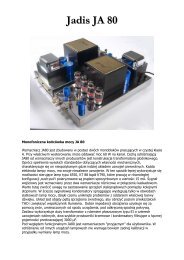And Cavi Sounds Sexier than Cables, Too, by Ken Kessler
And Cavi Sounds Sexier than Cables, Too, by Ken Kessler
And Cavi Sounds Sexier than Cables, Too, by Ken Kessler
Create successful ePaper yourself
Turn your PDF publications into a flip-book with our unique Google optimized e-Paper software.
<strong>And</strong> <strong>Cavi</strong> <strong>Sounds</strong> <strong>Sexier</strong> <strong>than</strong> <strong>Cables</strong>, <strong>Too</strong>, <strong>by</strong> <strong>Ken</strong> <strong>Kessler</strong><br />
Despite my avowed hatred of cables (see the August 23, 2005, eNewsletter),<br />
it is my duty as your faithful reporter to alert you to new wires of interest.<br />
Throw in such words as hand-made, affordable, and chic, and you can see why<br />
my interest was piqued in the new and terribly named Yter Audio <strong>Cables</strong>. <strong>And</strong><br />
if I tell you that these cables are Italian, you'll understand that the use of chic<br />
may not be so farfetched. There are two other words to consider: credibility<br />
and heritage, for—surprisingly—this all-new cable possesses both.<br />
Because one would assume that credibility and heritage are acquired only as<br />
<strong>by</strong>products of long experience and the passage of time, it should be revealed<br />
at the outset that the Yter cables (I won't even ask what Yter means) come<br />
from an impeccable source: Franco Serblin, of Sonus Faber fame. As I<br />
learned at Milan's TOP Audio show in September, Serblin is now in a state of<br />
semiretirement, having concluded his life's work with the sublime Stradivari<br />
Homage loudspeaker for Sonus Faber. While still connected to the firm, he<br />
has decided to branch out into another field, this time with his other son-inlaw,<br />
Massimiliano Favella. (Cesare Bevilacqua, president of Sonus Faber, is<br />
also married to one of Franco's daughters.)<br />
Favella's background is in metallurgy, Serblin's in audio. You know what<br />
happened next. Serblin had been experimenting with wire for some time, and<br />
Favella's knowledge has helped him realize the wiring he's always wanted to<br />
employ over a quarter-century of designing speakers. As it turns out,<br />
Serblin's last great speaker design (which is not to say that he's given up<br />
speakers entirely) used internal wiring that so captivated him, he tried it<br />
outside the speaker.<br />
"While designing the Stradivari Homage, I wanted to use internal wiring<br />
which was not merely derived from the telecommunication industry, solutions<br />
based on radio-frequency theory. Instead, I wanted wiring designed to<br />
handle wide-bandwidth frequencies and high power levels. So Massimiliano<br />
and I sought a new conductor based on this premise: the transfer of the<br />
audio signal from amplifier to speaker, especially at extremely low levels,
depends more on the physical structure of the metal <strong>than</strong> on the absolute<br />
value of conductivity in the wire."<br />
Serblin and Favella have developed the Well-Tempered Argentum Alloy to<br />
fulfill their desire to "intervene at a metallurgic level to obtain order and<br />
homogeneity of the conductor's crystalline structure, thus providing greater<br />
compliance of the music signal within the signal path." It combines the<br />
elements silver and palladium through a new three-phase process of fusion<br />
and melting, and the resultant wire has no sharp edges and a "Gaussian"<br />
shape. The company controls every stage of the wire's manufacture, from<br />
melting to drawing to, finally, construction. All wires are entirely handmade<br />
<strong>by</strong> Massimiliano Favella at the Yter Laboratorium.<br />
So far, only two Yter cable models are offered, and neither Serblin nor<br />
Favella suggests that new models will follow in the foreseeable future, due to<br />
the laws of supply and demand: Favella can make only so many per week.<br />
The speaker wire is available in standard lengths of 3m (about 10') and 5m<br />
(about 16'). Its single silver-palladium conductor is encased in a high-density<br />
polymer dielectric and terminated with banana plugs of the same alloy. The<br />
matching interconnect, in a standard 1m (39") length, is constructed<br />
identically but terminated in silver phono connectors made <strong>by</strong> WBT.<br />
While I want to avoid turning this into a quasi-review, suffice it to say that I<br />
was entirely seduced: Sonus Faber users will recognize the firm's finesse and<br />
delicacy. Physically, the cables are highly flexible, eschewing the whole<br />
naval-hawser macho bullshit. I loved that, too. They're positively svelte. <strong>And</strong><br />
when I learned that the prices were, at worst, manageable—hundreds of<br />
euros rather <strong>than</strong> thousands—I decided to add them to my review system.<br />
Franco Serblin said that talks were underway with a US distributor, still to be<br />
appointed at press time. If you want a pedigreed cable at a sane price that<br />
doesn't require a stevedore to bend it into position, investigate the Yters.<br />
I almost forgot the chic part: The Yter wires come supplied in utterly<br />
gorgeous, black leather portfolios that are so Italian it hurts. The best<br />
surprise of all emerged from a third, tiny wallet: a set of Yter's fabulous<br />
silver banana-to-spade converters, which come with a special tool for<br />
spreading the banana's socket end if it's too loose *. They've thought of<br />
everything. I guess we have to look on the Yter wires as the Armani suit of<br />
the cable world.<br />
* THE BANANA-TO-SPADE CONVERTERS ARE AN OPTIONAL ACCESSORY. THE TOOL TO SPREAD THE BANANA CONNECTORS IS<br />
INCLUDED WITH ALL SETS OF SPEAKER WIRES.
















